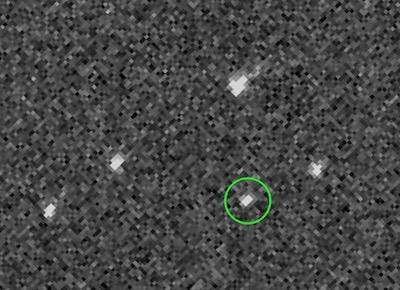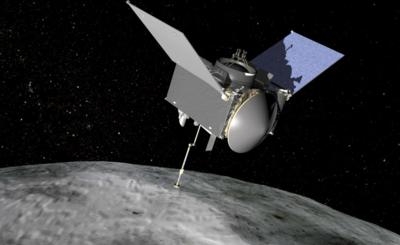Initial Image Captured From A Distance Of 1.4 Million Miles
After an almost two-year journey through space, NASA's asteroid sampling spacecraft, OSIRIS-REx, caught its first glimpse of asteroid Bennu last week and began the final approach toward its target. On Aug. 17, the spacecraft's PolyCam camera obtained the image from a distance of 1.4 million miles.

Led by the University of Arizona's Lunar and Planetary Laboratory, OSIRIS-REx is NASA's first mission to visit a near-Earth asteroid, survey the surface, collect a sample and deliver it safely back to Earth. The spacecraft has traveled approximately 1.1 billion miles since its Sept. 8, 2016 launch, and is scheduled to arrive at Bennu on Dec. 3.
"Now that OSIRIS-REx is close enough to observe Bennu, the mission team will spend the next few months learning as much as possible about Bennu's size, shape, surface features and surroundings before the spacecraft arrives at the asteroid," said Dante Lauretta, OSIRIS-REx principal investigator and professor of planetary science at the UA. "After spending so long planning for this moment, I can't wait to see what Bennu reveals to us."
To boost itself onto Bennu's orbital plane, OSIRIS-REx performed a slingshot maneuver, or gravity assist, around Earth 11 months ago. The craft is now zipping along at almost 32,000 mph relative to Earth, while catching up with Bennu at a little over 1,200 mph relative to the asteroid. The image was acquired using PolyCam, one of three cameras, all developed at the UA, that together comprise the OSIRIS-REx Camera Suite, OCAMS for short.
Polycam, so named because it is poly-functional, has two jobs: one as a long-range acquisition camera, and the second as a reconnaissance camera once the spacecraft gets close to Bennu. Obtaining the first visual of its target asteroid has been meticulously planned since the early development of the mission. According to OCAMS instrument scientist Bashar Rizk, who has been with the OSIRIS-REx team nearly from the beginning in 2006, almost every action that the spacecraft executes is preceded by a nine-week planning process that consists of program development and multiple tests and reviews, before the code is uploaded to the spacecraft via the Deep Space Antenna network.

Once the spacecraft has begun executing a command, there is very little, if any, ground communication involved, Rizk explained, and taking the first image of Bennu was no exception. When OSIRIS-REx reached the pre-determined position on its trajectory and turned on the camera for a series of 30 total exposures, the asteroid was exactly where mission planners predicted it would be weeks earlier.
"It's like a date," Rizk said. "You don't want to be late, and you don't want to be early."
"Right now, Bennu just looks like a star, a point source," said Carl Hergenrother, LPL staff scientist and OSIRIS-REx astronomy working group lead who proposed Bennu as the mission target during the early planning phase when the asteroid was simply known as 1999 RQ36. "That will change in November, when we will begin detailed observations and we'll start seeing craters and boulders. You could say that's when our asteroid will transition from being an astronomical object to an actual geological object."
As OSIRIS-REx approaches the asteroid, the spacecraft will use its science instruments to gather information about Bennu and prepare for arrival. In addition to the OCAMS camera suite, the spacecraft's science payload includes the OTES thermal spectrometer, the OVIRS visible and infrared spectrometer, the OLA laser altimeter and the REXIS X-ray spectrometer.
During the mission's approach phase, OSIRIS-REx will:
- Regularly observe the area around the asteroid to search for dust plumes and natural satellites, and study Bennu's light and spectral properties
- Execute a series of four asteroid approach maneuvers, beginning on Oct. 1, slowing the spacecraft to match Bennu's speed and trajectory
- Jettison the protective cover of the spacecraft's sampling arm in mid-October and subsequently extend and image the arm for the first time in flight
- Use OCAMS to reveal the asteroid's overall shape in late October and begin detecting Bennu's surface features in mid-November.
After arrival at Bennu, the spacecraft will spend the first month performing flybys of Bennu's north pole, equator and south pole, at distances ranging between 11.8 and 4.4 miles from the asteroid. These maneuvers will allow for the first direct measurement of Bennu's mass, as well as close-up observations of the surface. These trajectories will also provide the mission's navigation team with experience navigating near the asteroid.
"Bennu's low gravity provides a unique challenge for the mission," said Rich Burns, OSIRIS-REx project manager at NASA's Goddard Space Flight Center in Greenbelt, Maryland. "At roughly 0.3 miles [500 meters] in diameter, Bennu will be the smallest object that any spacecraft has ever orbited."
The spacecraft will extensively survey the asteroid before the mission team identifies two possible sample sites. Sample collection is scheduled for early July 2020, and the spacecraft will head back toward Earth before ejecting the Sample Return Capsule for landing in the Utah desert in September 2023.
"The story of this asteroid is the story of the solar system," Rizk said. "When we understand Bennu, we will understand something fundamental about our solar system."
(Source: University of Arizona news release. Images provided by NASA)
 ANN's Daily Aero-Term (04.26.24): DETRESFA (Distress Phrase)
ANN's Daily Aero-Term (04.26.24): DETRESFA (Distress Phrase) ANN's Daily Aero-Linx (04.26.24)
ANN's Daily Aero-Linx (04.26.24) Airborne 04.22.24: Rotor X Worsens, Airport Fees 4 FNB?, USMC Drone Pilot
Airborne 04.22.24: Rotor X Worsens, Airport Fees 4 FNB?, USMC Drone Pilot Airborne 04.24.24: INTEGRAL E, Elixir USA, M700 RVSM
Airborne 04.24.24: INTEGRAL E, Elixir USA, M700 RVSM Airborne-NextGen 04.23.24: UAVOS UVH 170, magni650 Engine, World eVTOL Directory
Airborne-NextGen 04.23.24: UAVOS UVH 170, magni650 Engine, World eVTOL Directory




